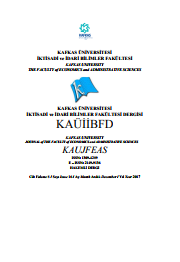BALKAN ÜLKELERİNDE İŞSİZLİK HİSTERİSİ VE DOĞAL ORAN HİPOTEZİNİN GEÇERLİLİĞİ: AMPİRİK BİR DEĞERLENDİRME
THE VALIDITY OF UNEMPLOYMENT HYSTERESIS AND NATURAL RATE HYPOTHESIS IN BALKAN COUNTRIES: AN EMPIRICAL EVALUATION
Author(s): Özgür Koçbulut, Süleyman BolatSubject(s): Economy, Geography, Regional studies, Labor relations, Evaluation research, Socio-Economic Research
Published by: Kafkas Üniversitesi Sağlık, Kültür ve Spor Daire Başkanlığı Dijital Baskı Merkezi
Keywords: Unemployment Hysteresis; Balkan Countries; Panel Unit Root Analysis;
Summary/Abstract: The study attempts to analyse the validity of the natural rate hypothesis and unemployment hysteresis approaches in the seven Balkan countries over the period 2004:1-2016:1 with quarterly datasets using second generation panel unit root tests. The hysteresis hypothesis indicates that the unemployment series follow unit root process, the natural rate hypothesis implies unemployment series is stationary. The methods which are used the analysis of this paper are SURADF panel unit root test by used Breuer et al. (2002); CADF panel unit root test developed by Pesaran (2007); panel KPSS unit root test that allows for structural breaks developed by Carrion-i Silvestre et al. (2005). The findings obtained from our paper display that the unemployment series are stationary in all countries for SURADF, CADF and PANKPSS test results. These results reveal that the transitory shocks in the Balkan countries do not seem to lead to the permanent effects on the unemployment rates and they show that the natural rate of unemployment hypothesis appears to be valid in Balkan countries.
Journal: Kafkas Üniversitesi İktisadi ve İdari Bilimler Fakültesi Dergisi
- Issue Year: 8/2017
- Issue No: 16
- Page Range: 295-317
- Page Count: 23
- Language: Turkish

